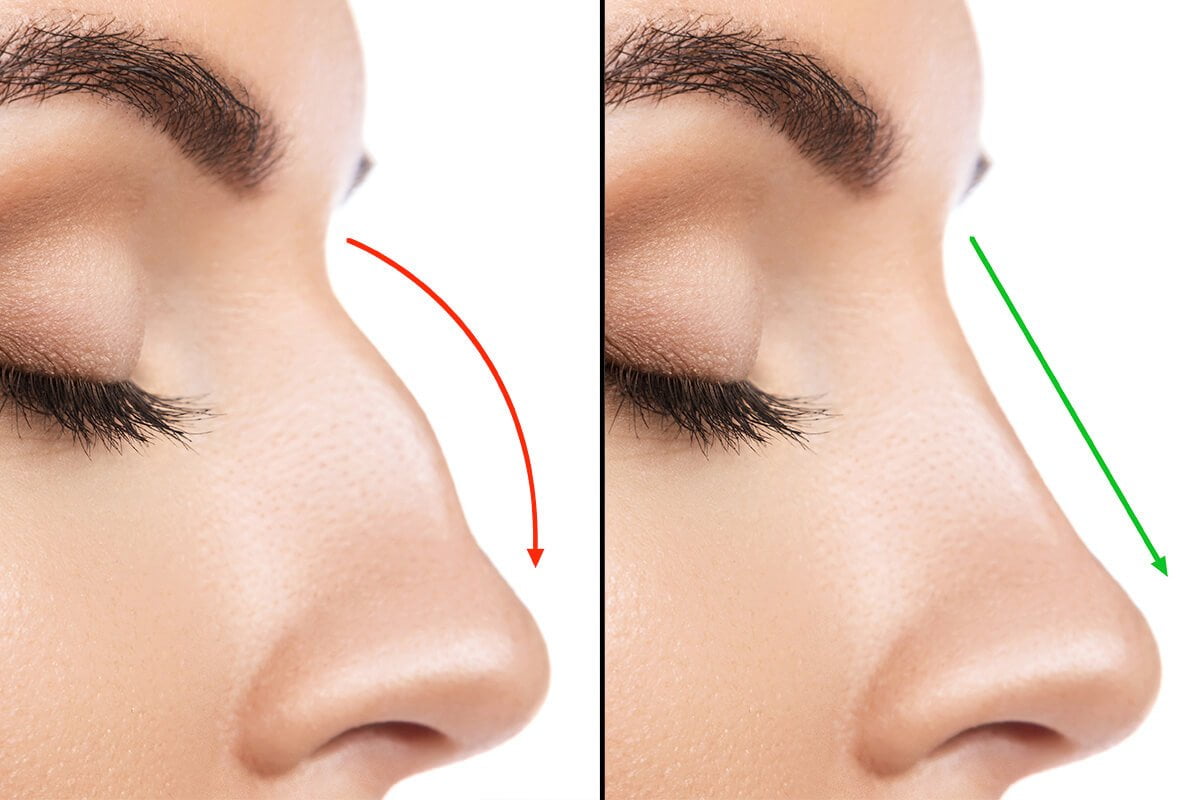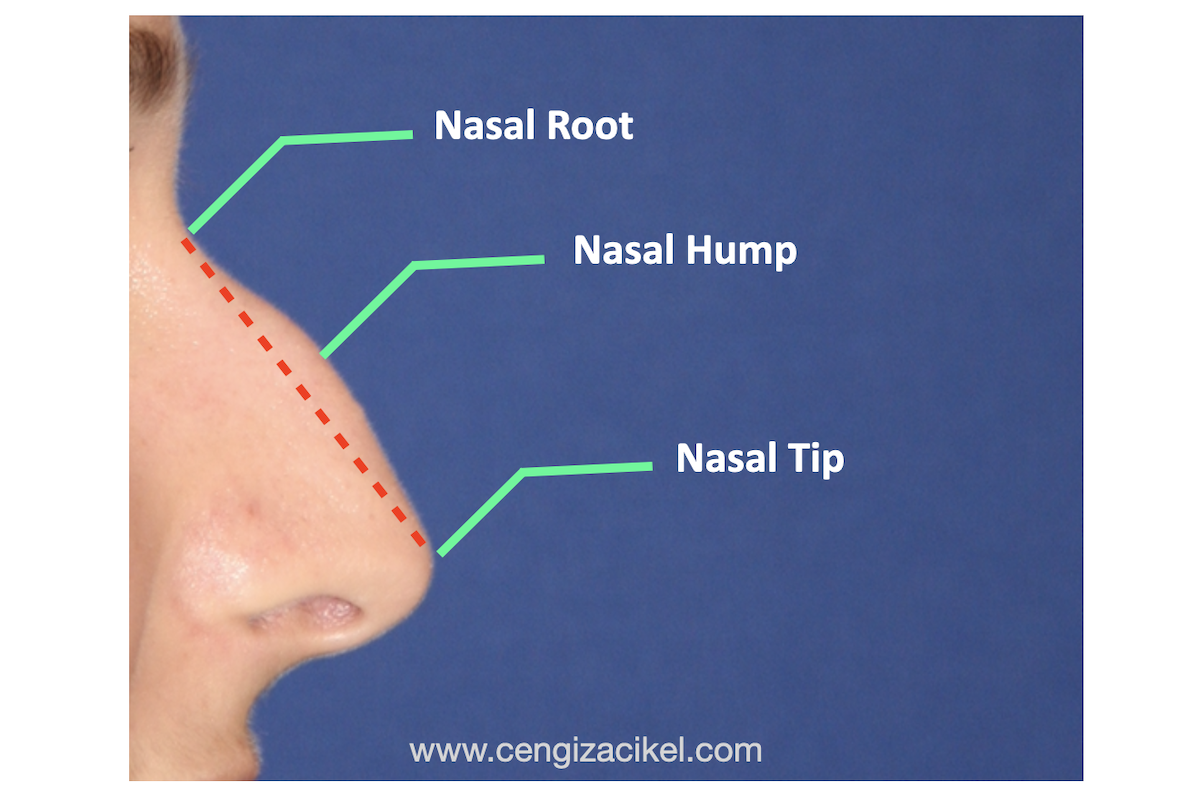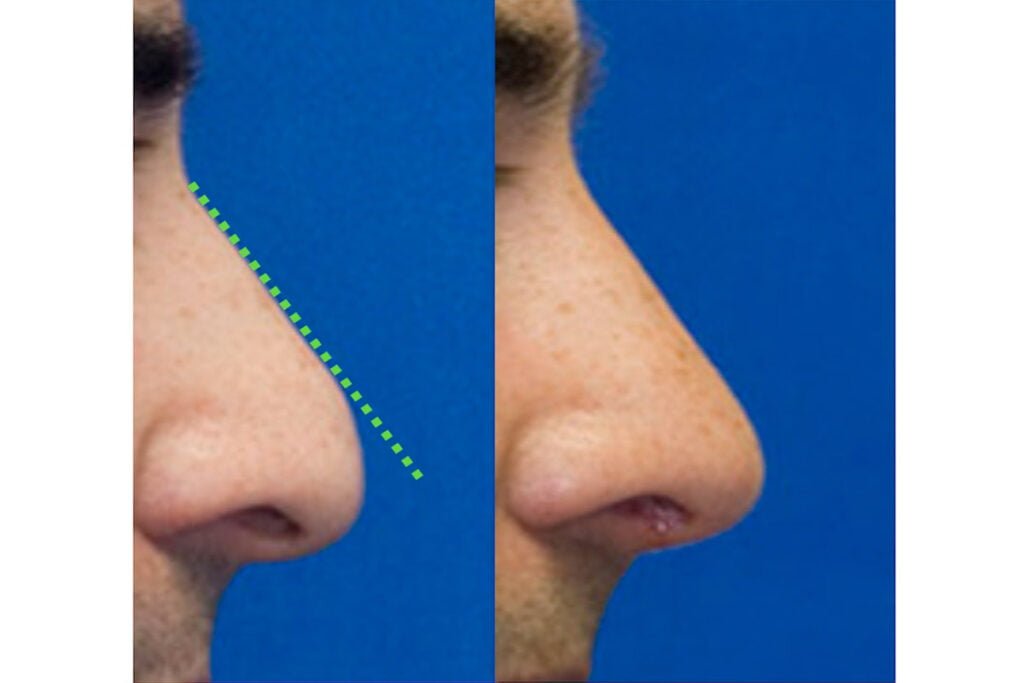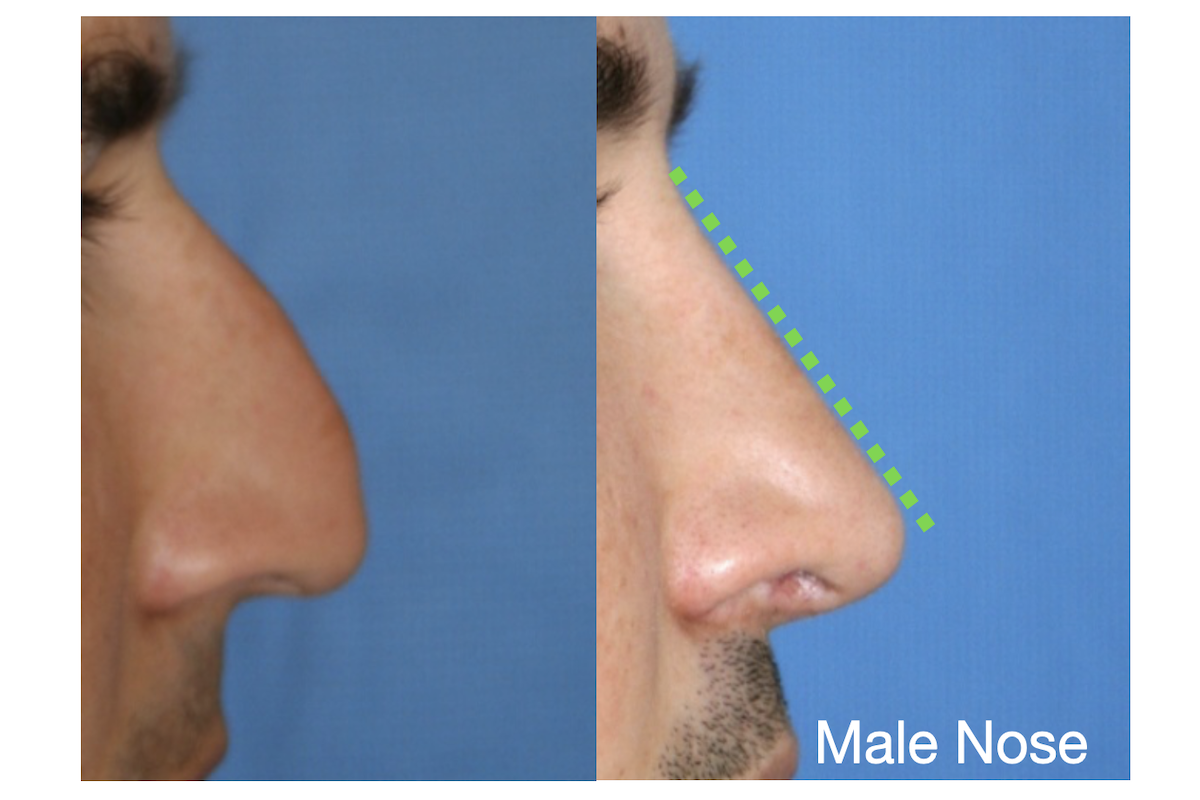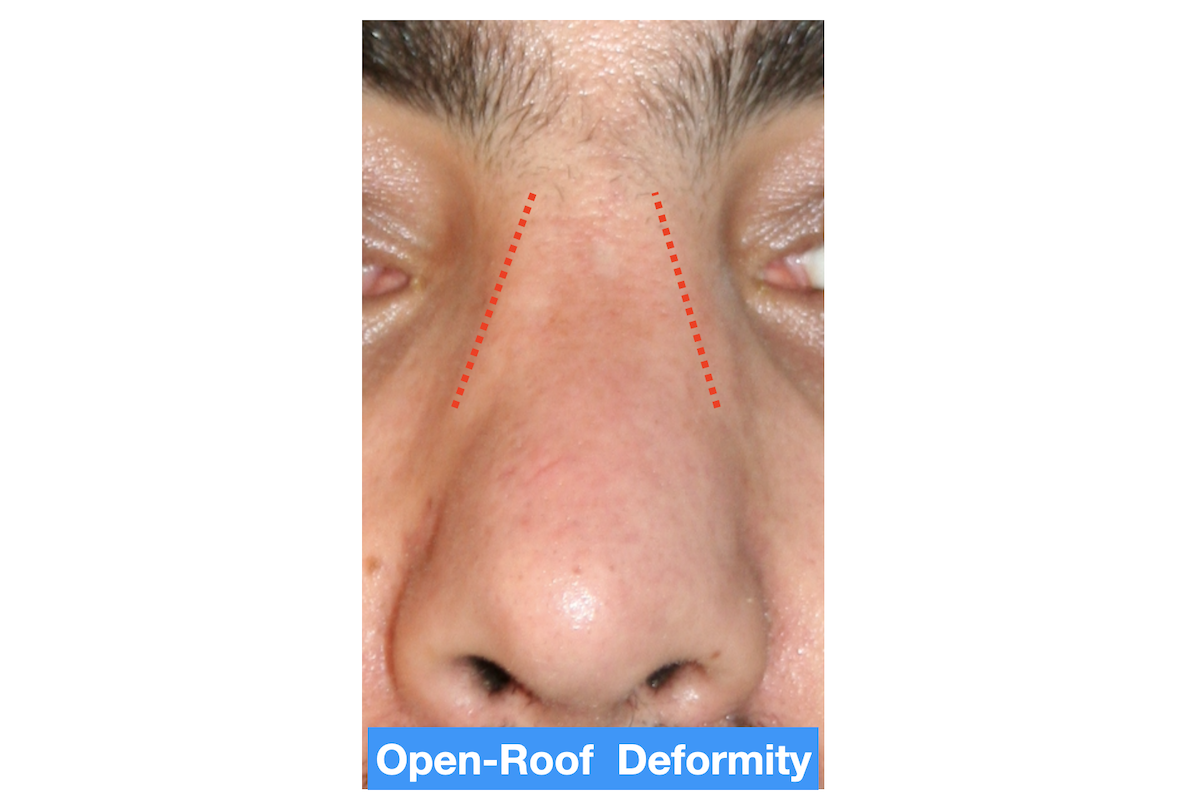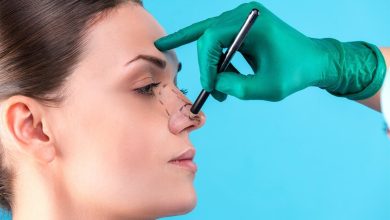Nasal Rasping Surgery
What is Dorsal Rasping?
Dorsal rasping is one of several surgical techniques used in rhinoplasty, also known as nose job. The deformation that needs to be corrected is not the same in every nose. For this reason, the nasal tip, nasal ridge, bone and cartilage roof of the nose, nasal wings, nostrils, nasofrontal (nose-forehead) angle, nasonasolabial (nose-upper lip) angle, and the relationship of the nose with other structures of the face are evaluated for each patient, the existing problems are identified, and an operation is planned accordingly.
Dorsal rasping (also known as nasal rasping) is a surgical procedure intended to straighten the nasal ridge in humped noses, which involves rasping the excess bone and cartilage tissues of the nasal ridge between the nasal root and nasal tip.
Types of Nasal Dorsal Hump and the Treatment Options
When a straight line is drawn in the profile view of the nose, which connects the nasal root (nose-forehead junction) and the tip of the nose, we can say there is a nasal dorsal hump deformity if the nasal ridge is higher than this line, instead of being in line with it or lower than it.
There are various anatomical causes of nasal dorsal hump, each of which requires a different treatment procedure. Therefore, the cause of the nasal dorsal hump should be thoroughly investigated before the operation, and the surgical plan should be made appropriately. The aim of the treatment is to align the dorsal line with the virtual straight line between the nasal root and nasal tip in men, or make it 1-2 mm lower than that line in women.
Types of Nasal Dorsal Hump and the Treatment Approaches:
- Nasal root and nasal tip projections are normal but there is a nasal dorsal hump
In the treatment of this type of nose, the excess bone and cartilage tissues are removed by rasping the nasal dorsal hump.
- There is an increased nasal tip projection and nasal dorsal hump
To correct this type of nose, first the nasal tip projection is reduced and then the nasal ridge is rasped down to eliminate the nasal dorsal hump.
- There is a pseudo-hump (false hump) due to low nasal tip projection.
Since the nasal tip projection is less than it should be, the virtual straight line between the nasal tip and the nasal root remains below the dorsal line, making the nose look as if it is a humped nose. Raising the nasal tip is the right approach to correct this type of nose. Rasping down the nasal ridge by taking a lower-than-normal nasal tip as a basis causes aesthetic and functional problems.
If the lower-than-normal nasal tip of such a nose is taken as a reference, the nose looks humped; however, the right treatment is to increase the projection of the nasal tip, as done in this patient, rather than rasp down the nasal ridge.
- The depth of the nasal root is greater than normal
The nasal root is further back than it should be, and due to the collapsed appearance of the nasal root, the nose looks humped, so the treatment should involve filling and raising the nasal root area. For this purpose, cartilage tissue, adipose tissue or ready-made fillers (permanent or temporary) can be applied underneath the skin of this area.
- Mixed-type nasal dorsal hump
There is a nasal dorsal hump, the height of the nasal tip height is not ideal, and the nasal root may look collapsed. In practice, it is the most common type of nose I see. In the treatment, first the height of the nasal tip is adjusted to the point where it should be (by reducing or increasing the nasal tip projection), and then the nasal dorsal hump is rasped down.
How Is The Ideal Nasal Tip Projection (Height) Determined?
After the nasolabial (nose-upper lip) angle is adjusted as required, the ratio between the nasal tip projection and the length of the nasal dorsal line extending from the nasal root to the nasal tip must be 1:0.67.
As can be understood from the information provided above, a thorough analysis should be performed prior to surgery in a nose with a dorsal hump, the face type should be determined and the relationship between the nasal root, nasal ridge, and nasal tip should be revealed. The factors causing the humped appearance should be determined, and the surgery should be planned accordingly. All these preoperative analysis, planning and surgical intervention processes require a vast accumulation of knowledge and experience.
How is The Dorsal Rasping Procedure Performed?
The vast majority of cases requiring dorsal rasping also require interventions on the nasal tip, nostrils, nasal angles, and nasal bones, and all of the procedures involving these interventions are referred to as rhinoplasty, nose job, or nose reshaping surgery. In other words, dorsal rasping is one of a series of surgical procedures in rhinoplasty, which is performed under general anesthesia.
The skin of the nasal ridge is separated from the bone and cartilage tissues beneath it using the closed or open technique, the nasal root and nasal tip are adjusted to the required heights, and the nasal ridge is rasped down using these two points as a reference. The rasping is done using chisels, rasps, and ultrasonic tools. After the rasping, the nasal bones are made mobile, and then the bone and cartilaginous roof of the nose is reconstructed.
How Much Does the Nasal Dorsal Hump Need To Be Rasped Down?
After the nasal root and nasal tip are adjusted to the appropriate heights, the dorsal line must be aligned with the virtual straight line between these two points in men, or must be 1-2 mm lower than this line in women. Especially in reshaping a female nose, the entire face should be reviewed, and the nasolabial (nose-upper lip) angle and nose profile should be determined based on the face type. More curved and upturned noses can be compatible with some face types, while more flat and sharp-angled noses can be compatible with some others.
Does a dorsal rasping operation require intervention in the nasal bones?
The triangular prism-shaped nasal roof is impaired when excess bone and cartilage tissue on the nasal ridge is rasped down, and as a result, the roof constituted by the nasal bones in the nasal ridge is impaired. For this reason, the right and left nasal bones are mobilized using a variety of techniques and brought closer to each other in such a way as to form a roof again, and then they are molded to maintain the new configuration. If this procedure is not performed, the nasal bones do not join together to form a roof; instead, they stand apart from each other, resulting in a deformity known as “open roof deformity” on the nasal ridge.
Our patients frequently ask the question, “Can you only rasp down the nasal ridge without touching the nasal bones?” In cases where the nasal dorsal hump is not due to the nasal bones, but only to the excess portions of the nasal cartilages, the procedure can involve rasping alone.
However, the cause of the dorsal hump is mostly an excess of cartilage and bone structures, and when the bone roof is rasped, the nasal bones must be made mobile and the roof must be reconstructed. During the preoperative examination, your plastic surgeon will you explain what type of procedure is required for your nose.
Does a dorsal rasping operation involve intervention in other parts of the nose?
In practice, operations mostly involve interventions on the nasal tip, nostrils, septal part inside the nose, nostrils, and nasal wings to reshape the nose three-dimensionally; and the procedure that involves all these interventions is referred to as rhinoplasty, nose job, or nose reshaping surgery as a whole.
Does Dorsal Rasping Involve Any Risk?
As with all surgical procedures, dorsal rasping has some risks in terms of anesthesia and surgical intervention. In this section, I’d like to emphasize the aesthetic risk in particular. When bone and cartilage structures are rasped more than necessary during dorsal rasping, the nasal roof collapses.
This will not only cause an aesthetically bad appearance, but will also impair the nasal breathing function. Therefore, dorsal rasping should be done with great care, and extra cartilage supports should be provided to protect the distances and angles required for the breathing function of the nose (internal valve).
Who is a candidate for rhinoplasty?
Suitable candidates are those who have completed 18 years of age, have no physical or mental health problems, have a nose with a dorsal hump and are uncomfortable with this appearance, and have realistic expectations from the operation.
Is dorsal rasping a plastic surgery procedure?
Yes, dorsal rasping is a plastic surgery procedure and it is not covered by insurance companies.
Can dorsal rasping be done under local anesthesia?
A very limited number of operations, such as those which involve rasping only the cartilage parts, can be performed under intravenous sedation and local anesthesia, but in my practice, I perform all of my dorsal rasping operations under general anesthesia because the majority of these operations also require interventions on the nasal bones and other parts of the nose.
Is revision required after dorsal rasping?
If the nasal ridge has been rasped down excessively or inadequately, if the bone roof reconstructed with the nasal bones remained open, or the desired straight dorsal line could not be achieved, a revision surgery may be required and this surgery may need to be performed at least 1 year after the dorsal rasping procedure.
Swelling and edema after rhinoplasty
There will be mild or severe swelling and edema after rhinoplasty. This swelling will start on the night of the surgery and will peak the next night. In the following days, it will start moving downward from the top, that is, the eye contour area, first to the cheeks, then to the upper lip, the lower jaw, and the neck respectively, and will disappear completely over time.
The degree of swelling in the nose and surrounding structures such as the eyes, cheeks, and upper lip after rhinoplasty varies depending on a variety of factors. The extent of the correction to be made in the nose is one of these factors. Operations that do not involve any intervention other than slightly rasping down the nasal bones or that involve only the interventions on the nasal tip will cause less postoperative swelling.
On the other hand, more swelling and edema will be observed after the operations in which the nasal roof will be reshaped by intervening on the nasal bones, and also after the operations in which structures such as the concha and deviated septum in the nose will be intervened. However, even if the surgery is performed in the same way, not every person will have the same edema because the tissues of individuals do not have the same properties.
Some people have a structure that is more prone to edema and swelling. In addition, whether the patient remains in a semi-sitting position after the operation, whether or not cold is applied after the operation, excessive straining after the operation, frequent sneezing, high blood pressure, etc. are some other factors that play a role in the degree of swelling.
Dos and don’ts after dorsal rasping
There are some practices widely accepted by surgeons and are applicable to all rhinoplasty procedures. These include but not limited to staying in a semi-sitting position in bed in the first postoperative hours, applying cold to the area around the nose and staying as calm as possible. The patient starts consuming food orally 2 hours after the operation, and a few hours later, he or she can stand up and take a short walk with the help of the nurse. It is natural to observe a bit blood leakage from the nose during this period.
Excessively leaning forward and straining on the toilet should be avoided. In the days following the dorsal rasping surgery, the inside of the nose should be kept clean in accordance with the physician’s instructions, and the recommendations should be strictly followed.
Drugs and foods with blood thinning effect including nutritional supplements and herbal products such as green tea should be avoided for a period of at least two weeks after surgery. Adequate amount of fluid and protein-rich food should be consumed.
When the bands on the nose are removed after the dorsal rasping surgery, the first nose shape you will see is not the final shape of your nose; it will have an edematous, swollen appearance compared to its real appearance. During this process, you should refrain from commenting on the aesthetic appearance, and should wait for the edema to subside. You should avoid any nasal trauma especially in the first 6 weeks after the operation.
Cost of Dorsal Rasping In 2024
Costs of dorsal rasping operations vary depending on the hospital where the surgery will be performed, the difficulty level of the surgery, and the initiative of the plastic surgeon that will perform the surgery. You can contact our office to know the surgery price that will be determined for you.
